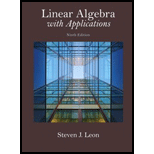
Let
for each
Want to see the full answer?
Check out a sample textbook solution
Chapter 4 Solutions
Linear Algebra with Applications (9th Edition) (Featured Titles for Linear Algebra (Introductory))
Additional Math Textbook Solutions
University Calculus
University Calculus: Early Transcendentals (4th Edition)
Introductory Statistics
Elementary Statistics: Picturing the World (7th Edition)
Elementary Statistics (13th Edition)
A First Course in Probability (10th Edition)
- Pls help.arrow_forwardSolve the system of equation for y using Cramer's rule. Hint: The determinant of the coefficient matrix is -23. - 5x + y − z = −7 2x-y-2z = 6 3x+2z-7arrow_forwarderic pez Xte in z= Therefore, we have (x, y, z)=(3.0000, 83.6.1 Exercise Gauss-Seidel iteration with Start with (x, y, z) = (0, 0, 0). Use the convergent Jacobi i Tol=10 to solve the following systems: 1. 5x-y+z = 10 2x-8y-z=11 -x+y+4z=3 iteration (x Assi 2 Assi 3. 4. x-5y-z=-8 4x-y- z=13 2x - y-6z=-2 4x y + z = 7 4x-8y + z = -21 -2x+ y +5z = 15 4x + y - z=13 2x - y-6z=-2 x-5y- z=-8 realme Shot on realme C30 2025.01.31 22:35 farrow_forward
- Use Pascal's triangle to expand the binomial (6m+2)^2arrow_forwardListen A falling object travels a distance given by the formula d = 6t + 9t2 where d is in feet and t is the time in seconds. How many seconds will it take for the object to travel 112 feet? Round answer to 2 decimal places. (Write the number, not the units). Your Answer:arrow_forwardSolve by the quadratic formula or completing the square to obtain exact solutions. 2 e 104 OA) -16±3√6 B) 8±√10 O c) -8±√10 OD) 8±3√√6 Uarrow_forward
 Elementary Linear Algebra (MindTap Course List)AlgebraISBN:9781305658004Author:Ron LarsonPublisher:Cengage Learning
Elementary Linear Algebra (MindTap Course List)AlgebraISBN:9781305658004Author:Ron LarsonPublisher:Cengage Learning Linear Algebra: A Modern IntroductionAlgebraISBN:9781285463247Author:David PoolePublisher:Cengage Learning
Linear Algebra: A Modern IntroductionAlgebraISBN:9781285463247Author:David PoolePublisher:Cengage Learning

